Airfix 1/72 FW-190A/F-8
|
KIT: |
Airfix 1/72 FW-190A/F-8 |
|
KIT #: |
02085 |
|
PRICE: |
$currently out of production |
|
DECALS: |
Two options |
|
REVIEWER: |
Brian Baker |
|
NOTES: |
Can relatively easily be found at swap meets. |
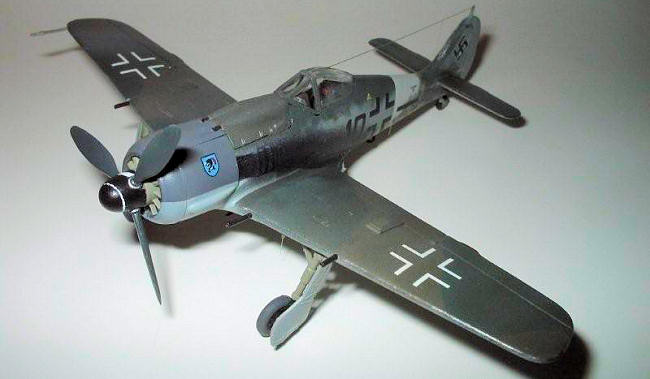
The Focke Wulf FW-190A was
probably the best piston engine fighter the Luftwaffe had during World War II,
especially some of the later liquid
cooled engine variants, such as the FW-190D and the TA-152H series.
Appearing during 1941, the FW-190A
was used right up until the end, and in some air forces, notably the French and
Turkish, they were used postwar.
The only drawback of the A model
was the lack of high altitude performance, which was countered by good low
altitude performance and a versatility that resulted in its extensive use in the
ground attack and close support roles.
There have been about 90
different kits of the various types of FW-190 issued over the years in 1/72
scale alone, (see my article on
1/72 scale FW-190 kits),
and this is the first one that could really be called a decent kit of the
airplane.
First ap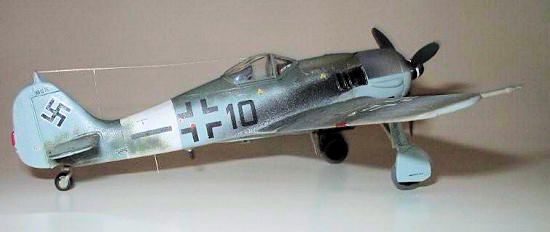 pearing
in the late seventies, the fuselage is copyrighted 1977, the kit was actively
market until the nineties, and is still available at swap meets and IPMS
meetings throughout the country.
Originally issued by Airfix, it
also appeared under the MPC label, and must have produced in the thousands.
The
kit suffers from a number of problems, including very thick landing gear doors,
raised panel lines, minimal interior detail, and the like, but overall, it
presents a reasonably accurate outline and several armament options. It lacks
the small breech covers for the outboard cannon, along with the retractable
steps that usually appear in photos of FW-190’s on the ground.
pearing
in the late seventies, the fuselage is copyrighted 1977, the kit was actively
market until the nineties, and is still available at swap meets and IPMS
meetings throughout the country.
Originally issued by Airfix, it
also appeared under the MPC label, and must have produced in the thousands.
The
kit suffers from a number of problems, including very thick landing gear doors,
raised panel lines, minimal interior detail, and the like, but overall, it
presents a reasonably accurate outline and several armament options. It lacks
the small breech covers for the outboard cannon, along with the retractable
steps that usually appear in photos of FW-190’s on the ground.
By
the way,
the Airfix FW-190D-9, which was
issued in 1976, a year before the A model, is an entirely different kit, and
very little is interchangeable with the A kit.
When the kit first came out, I was
hoping that I could do a flat canopy D model using the extra canopy from the A
kit, but it doesn’t fit.
Focke Wulf apparently had more
parts commonality between the two versions than did Airfix.
The
canopies, of which two are provided, are of the flat type used for most A’s up
through the A-8, and the
“bubble” type, which was used for
some A-8’s and most F-8’s,
but
do not provide for an opened cockpit, but then, there isn’t much detail to see
inside the cockpit anyway.
If you want to have the hatch slid
back, the canopies from the Hasegawa kit, or any other for that matter, work
fine, and I have done this modification on a number of Airfix kits over the
years. The wheel well detail is minimal, although a
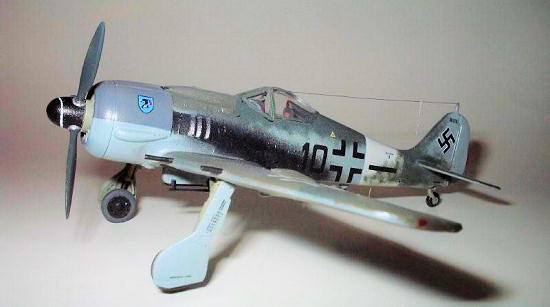 center
section does provide some realistic portions.
Aftermarket materials will solve
that problem.
But the main components, the wings,
fuselage,
tailplane, prop and spinner, etc.,
are right on the money,
and a little removal of raised
panel lines and some creative scribing will result in an acceptable model, even
with a kit of this vintage. One particularly good feature of this kit is that,
even though the wing and tail trim tabs lack some detail, the wing trailing
edges are perfectly straight, a shape that is not correctly represented on some
of the newer, more expensive kits.
Just look at a photo of an FW-190
showing the wing trailing edge, and you will see that the flap and aileron lines
are perfectly straight.
For some reason, some kit
manufacturers make the chord of the aileron a little longer than it should be.
center
section does provide some realistic portions.
Aftermarket materials will solve
that problem.
But the main components, the wings,
fuselage,
tailplane, prop and spinner, etc.,
are right on the money,
and a little removal of raised
panel lines and some creative scribing will result in an acceptable model, even
with a kit of this vintage. One particularly good feature of this kit is that,
even though the wing and tail trim tabs lack some detail, the wing trailing
edges are perfectly straight, a shape that is not correctly represented on some
of the newer, more expensive kits.
Just look at a photo of an FW-190
showing the wing trailing edge, and you will see that the flap and aileron lines
are perfectly straight.
For some reason, some kit
manufacturers make the chord of the aileron a little longer than it should be.
The
reason I went back in my “10 year supply” of kits to build this one was because
I was given an aftermarket FW-190A detail set for an IPMS review,
intended for the
Monogram/Revell FW-190A-8, and
since I had some parts left over, I figured, why not do another FW-190A-8 to go
with the many I already have. The Monogram kit has some basic outline problems
in the nose section, but is otherwise excellently done. It was a good comparison
kit to do while building the Monogram kit.
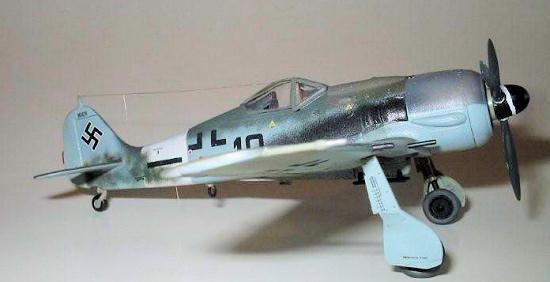 I
had an unbuilt Hasegawa FW-190A-8, and also an aftermarket cockpit interior for
it, so I decided to use the Hasegawa cockpit on the Airfix kit.
Strangely enough, it fit perfectly,
and only needed to be glued in place.
It is rather minimal, which is why
the aftermarket set was made, but through the thick Airfix canopy, you can’t see
much anyway, so it’s not much of an issue.
Since the aftermarket conversion
kit for the Revell/Monogram contained new resin landing gear doors, I used the
Revell doors on my Airfix kit, and it was an improvement.
I also used the centerline bomb
rack from the Revell kit, although the Airfix kit has an acceptable unit.
I
had an unbuilt Hasegawa FW-190A-8, and also an aftermarket cockpit interior for
it, so I decided to use the Hasegawa cockpit on the Airfix kit.
Strangely enough, it fit perfectly,
and only needed to be glued in place.
It is rather minimal, which is why
the aftermarket set was made, but through the thick Airfix canopy, you can’t see
much anyway, so it’s not much of an issue.
Since the aftermarket conversion
kit for the Revell/Monogram contained new resin landing gear doors, I used the
Revell doors on my Airfix kit, and it was an improvement.
I also used the centerline bomb
rack from the Revell kit, although the Airfix kit has an acceptable unit.
One
feature of the Airfix kit is the variety of armament combinations that can be
installed.
The access plates underneath the
wings are open, and you can install cannon shell ejectors, bomb racks as were
common on the F model, or twin 20 mm gun packs which were used rarely in
service.
There are a number of pre-drilled
partial holes in the wing lower half, and these can be drilled out for specific
armament combinations.
They also provide a pretty nice DF
loop antenna for underneath the fuselage, a feature not provided in some later
kits.
Editor's Note: If you want to know how the kit goes
together, then you may wish to visit my
earlier article on
this subject.
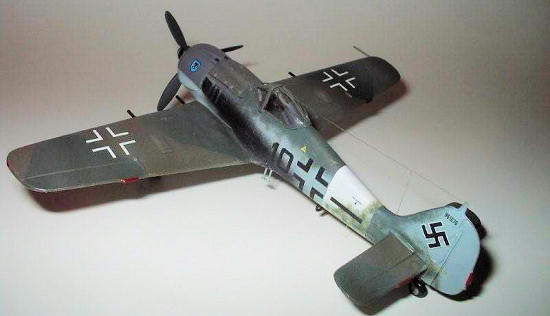 Awhile
back, I bought a bunch of Aeromaster Luftwaffe decals, including the Rammjagers
Part II issue, and I discovered one that I hadn’t done yet, an FW-190A-8 that
the pilot,
Obfgtr. Axel Kessler, an Estonian,
flew to Sweden in April 1945. I wonder why.
The plane is covered in Widfeldt’s
Luftwaffe in Sweden book, which gives a graphic account of all Luftwaffe
aircraft that landed in Sweden, for whatever reason, during World War II.
The aircraft, w/n 961076, Black 10,
of 5/JG 4, was interned in Sweden, and probably scrapped soon afterwards.
There is a
passable
photo of the airplane in the book, along with some color information both in the
book and on the decal sheet.
The Widfeldt book differs with the
decal maker on the colors, and I opted for the book’s scheme which was close to
the usual 74/75/76, only with heavy weathering and marking obscuration.
The result was another FW-190A in
late war markings, an era that I like to model.
Awhile
back, I bought a bunch of Aeromaster Luftwaffe decals, including the Rammjagers
Part II issue, and I discovered one that I hadn’t done yet, an FW-190A-8 that
the pilot,
Obfgtr. Axel Kessler, an Estonian,
flew to Sweden in April 1945. I wonder why.
The plane is covered in Widfeldt’s
Luftwaffe in Sweden book, which gives a graphic account of all Luftwaffe
aircraft that landed in Sweden, for whatever reason, during World War II.
The aircraft, w/n 961076, Black 10,
of 5/JG 4, was interned in Sweden, and probably scrapped soon afterwards.
There is a
passable
photo of the airplane in the book, along with some color information both in the
book and on the decal sheet.
The Widfeldt book differs with the
decal maker on the colors, and I opted for the book’s scheme which was close to
the usual 74/75/76, only with heavy weathering and marking obscuration.
The result was another FW-190A in
late war markings, an era that I like to model.
This
kit is certainly not up to the standards of Hasegawa and Tamiya,
but it is an accurate
representation of one of my favorite aircraft, and it is quick and fun to build.
With a little effort, it can be built into a reasonably good representation of
Kurt Tank’s masterpiece.
Don’t throw these away; they still
have value. Airfix did a classic with this little bird.
Brian Baker
April 2008
If you would like your product reviewed fairly and quickly, please
contact
me or see other details in the
Note to
Contributors.
Back to the Main Page
Back to the Review
Index Page


 pearing
in the late seventies, the fuselage is copyrighted 1977, the kit was actively
market until the nineties, and is still available at swap meets and IPMS
meetings throughout the country.
Originally issued by Airfix, it
also appeared under the MPC label, and must have produced in the thousands.
The
kit suffers from a number of problems, including very thick landing gear doors,
raised panel lines, minimal interior detail, and the like, but overall, it
presents a reasonably accurate outline and several armament options. It lacks
the small breech covers for the outboard cannon, along with the retractable
steps that usually appear in photos of FW-190’s on the ground.
pearing
in the late seventies, the fuselage is copyrighted 1977, the kit was actively
market until the nineties, and is still available at swap meets and IPMS
meetings throughout the country.
Originally issued by Airfix, it
also appeared under the MPC label, and must have produced in the thousands.
The
kit suffers from a number of problems, including very thick landing gear doors,
raised panel lines, minimal interior detail, and the like, but overall, it
presents a reasonably accurate outline and several armament options. It lacks
the small breech covers for the outboard cannon, along with the retractable
steps that usually appear in photos of FW-190’s on the ground. center
section does provide some realistic portions.
Aftermarket materials will solve
that problem.
But the main components, the wings,
fuselage,
tailplane, prop and spinner, etc.,
are right on the money,
and a little removal of raised
panel lines and some creative scribing will result in an acceptable model, even
with a kit of this vintage. One particularly good feature of this kit is that,
even though the wing and tail trim tabs lack some detail, the wing trailing
edges are perfectly straight, a shape that is not correctly represented on some
of the newer, more expensive kits.
Just look at a photo of an FW-190
showing the wing trailing edge, and you will see that the flap and aileron lines
are perfectly straight.
For some reason, some kit
manufacturers make the chord of the aileron a little longer than it should be.
center
section does provide some realistic portions.
Aftermarket materials will solve
that problem.
But the main components, the wings,
fuselage,
tailplane, prop and spinner, etc.,
are right on the money,
and a little removal of raised
panel lines and some creative scribing will result in an acceptable model, even
with a kit of this vintage. One particularly good feature of this kit is that,
even though the wing and tail trim tabs lack some detail, the wing trailing
edges are perfectly straight, a shape that is not correctly represented on some
of the newer, more expensive kits.
Just look at a photo of an FW-190
showing the wing trailing edge, and you will see that the flap and aileron lines
are perfectly straight.
For some reason, some kit
manufacturers make the chord of the aileron a little longer than it should be.
